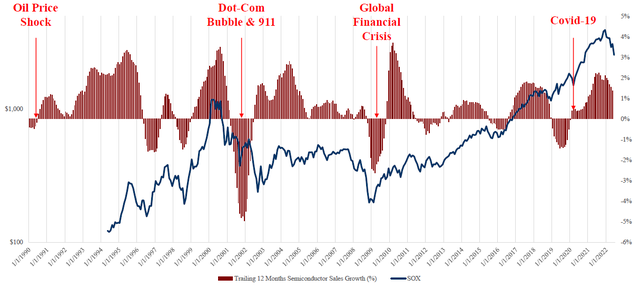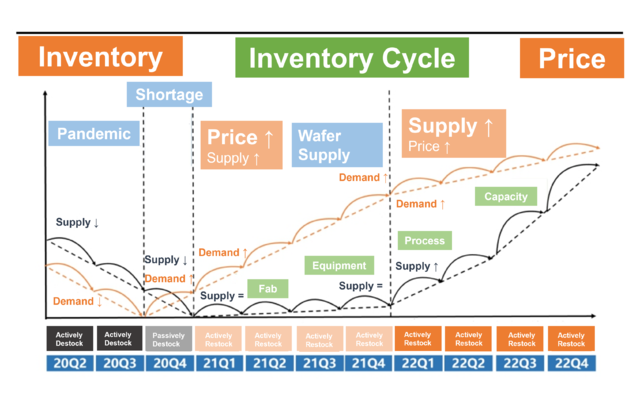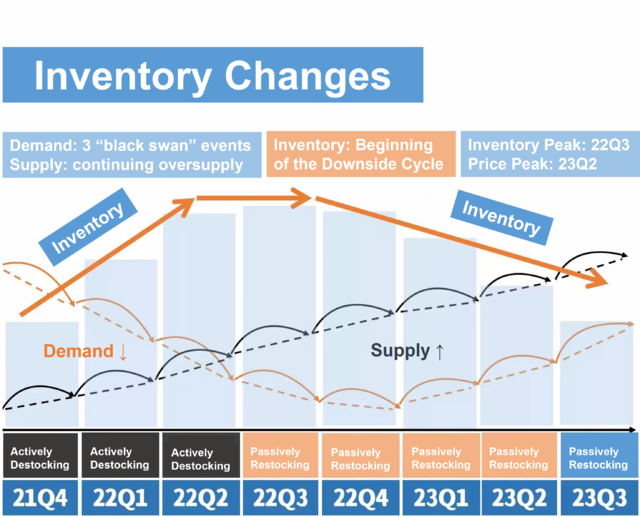When will the semiconductor industry cold winter end?
When will the semiconductor industry cold winter end?
Order, unpaid leave, layoffs... semiconductors into a downward cycle.
Semiconductor enterprise inventory eased slightly, a wave of layoffs swept across the industry. The market for 2022 is just like a bungee jump.
Some people worry about their inventory, some people have difficulty in changing careers, and some people are about to lose their jobs."In order to survive," many companies have had to do their best.
The semiconductor industry is experiencing its worst recession since the dotcom bubble in 2000. A prominent fund manager who has invested heavily in the semiconductor industry said the semiconductor industry will be the worst of the industry.
We knows knows, but how long is the cycle?
There are many charts that show the cyclity of the semiconductor industry.

Each recession in the cycle records the industry's rolling story.
By the end of 2020 to early 2021, many chips are in short supply. As supply increased, several agencies last year predicted that the chip shortage would end by the end of 2022.

Figure 1: An analyst made it in January this year
One is the forecast for the four quarters of 2022.21Q4 to 22Q4, the semiconductor market from price rise to volume increase. Demand is expected to rise, not fully met, showing a strong outlook.
At that time (January 2022), the institute said we were in the third phase of the widening price gap for 5G infrastructure, consumer electronics upgrades, carbon neutrality and autonomous driving.
But even the same institute's predictions are valid at only one stage. The red "black swan" event occurred when everyone believed that supply would continue to meet the strong demand market.

Figure 2: Made by the same analyst in November of this year
Figure 2 shows the actual situation of the past time period. From 21Q4 to 22Q2, there were three "black swan" events in demand for three consecutive quarters. Demand began to decline sharply from 21Q4, high inventory, supply exceeds demand. By 22Q4, demand fell to freezing point.
Everyone knows the periodicity, but it's hard to predict how long the cycle is. Some people later realized that the burning market was drawing to an end.
Smartphones, computers, TVS, panels and consumer chip companies are not replenishment, but worried about destocking. Spot market prices fell sharply, and chip designer Elan would rather pay high liquidated damages than keep orders to avoid high inventories.
The semiconductor industry is experiencing the worst recession since the dotcom bubble in 2000 and one of the biggest, according to the industry's history. CAI, a prominent fund manager, said the semiconductor industry was the worst of all industries in 2022.
Even domestic chips, which can replace foreign chips, are being hit because they are mainly used in consumer products.
According to a colleague in the chip circulation industry, now foreign big goods are stable, the price is competitive, domestic brands also appear one after another, customers began to shop around. The company is the agent of many Chinese domestic brands, some mobile phone manufacturers orders reduced by more than 40%. In 2022, orders for consumer chips fell sharply.
That day came earlier than expected. Consumer chips in the global industry cycle has been "near the sunset", semiconductor stocks have also fallen very miserably.
High inventory, order reduction, layoffs, and bankruptcy
According to the results of Electronics Supply and Manufacturing (ESM) electronic components procurement survey in the third quarter of 2022,80.5% of the surveyed enterprises suffered consumer electronics order reduction in Q3; the remaining 20% of the surveyed enterprises did not serve the automotive industry, industry, power and other industries, not cold.
In order to stop their losses in time, chip design companies have to cut orders even if the penalty is very high.
With weak demand in the second and third quarters of this year, IC design company inventory levels continued to climb. In order to prevent inventory out of control, some enterprises began to reduce wafer construction in the second and third quarters, and pay liquidated damages.
From order cuts to layoffs, from downstream terminal manufacturers to upstream foundries, the bad news about the industry chain continues to come out:
Broken orders from downstream to upstream
Samsung: Samsung expects to cut production by 30 million phones by 2022, to 280 million from 310 million. The price cut covers all prices for Samsung phones, including its flagship phones.
Apple: According to Taiwan media reports at the end of October, Apple has decided to cut its iPhone 14 Plus production by about 40% due to the cold market, and the total shipment gap will be covered by other models. Apple has even begun to slash orders for A15 and A16 chips, even the iPhone 14 Pro that its new earnings report has touted, industry sources said.
Qorvo: RF chip and component industry sources, a major RF chip maker, has cut UMC's wafer start in violation of the long-term agreement with UMC (LTA) due to increased demand uncertainty, according to Digitimes.
Mediatek: According to forfork, Mediatek slightly lowered its annual shipment forecast for smartphone chips to 57 billion to 6 billion units. Among them, Breguet 9000 chip shipments in 2022 or reduce from 10 million sets to 50-6 million sets.
Qualcomm: Tianfeng Securities said that Qualcomm's flagship chip platform snapdragon 8 Gen1 orders fell by about 10-15% in the second half of the year, and SM8475 and SM8550 shipments are expected to remain unchanged. The company expects SM450 and SM8475 to cut by 30%40%, when SM8550 shipments, inventory clearance.
Renesas, Anson: Morgan Stanley said in its latest report that from the latest survey of semiconductor wafer foundry processes, some automotive semiconductor suppliers, including Renesas and Ansom, are cutting some chip testing orders. The fourth quarter, indicating that automotive chips are no longer in short supply.
Elan: Elan, a chip design firm, announced on November 3 that it is ending its three-year long-term agreement with wafer foundry because the destocking schedule is not expected and customers continue to reduce shipments and will pay liquidated damages to the foundry in the fourth quarter.
Small and medium-sized chip design enterprises: It is reported that a number of small and medium-sized IC design enterprises with a relatively high PC proportion continue to reduce the wafer start or negotiate to delay the delivery. It is difficult to predict when the market will recover.
The wave has spread from terminal equipment manufacturers and chip design companies to foundries.
According to the survey of Qunzhi Consulting, from Q22022, the capacity utilization rate of foundry began to decline due to the reduction of downstream customers.8-inch wafer fab are more affected than 12-inch fas because of a single product structure.
Capacity utilization of VIS and PSMC fell to around 90% in Q3 2022 and is expected to decline in Q42022.
Worse than the unpaid holidays are the layoffs
Silicon Valley is synonymous with the gathering of high-tech companies, such as semiconductor companies. However, Silicon Valley is experiencing a huge wave of layoffs. More than 100,000 jobs have been cut in the tech sector this year. Of that, 27,000 jobs were cut in May and June, 200% of the same period last year. Laycuts surged 48% in October from a year earlier. In addition, high-tech enterprises in the Hsinchu Science Park, known as Taiwan's "Silicon Valley", give their employees "unpaid holidays".
Display drive IC factory: Taiwan media reported on November 7, after the executive salary increase in October, the situation of drive IC factory is even worse. A factory followed by cutting cuts for senior managers and plans to start cutting workers before the Spring Festival. This is the first industry to face a storm of layoffs in the electronics industry downturn.
Memory: In early 2022, Micron disbanded its DRAM design team in Shanghai and laid off its chip designers. Seagate, the world's largest maker of computer hard drives, announced a restructuring plan on October 24th. The plan, designed to reduce costs, includes layoffs of about 3,000 employees, or about 8% of its global workforce.
Intel: Chip maker Intel will announce thousands of job cuts before and after the third-quarter results, with the company's sales and marketing division being the most affected, according to a person familiar with the matter. Intel had 113,700 employees as of July, and could lay off about 20 percent of its sales and marketing division.
Marvell: On October 26, it was announced that Marvell would cut most of its research and development teams in China, leaving only some of its design and service staff in Nanjing.
Global Foundries: On November 15, Global Foundries, the largest chip foundry in the United States, announced that it will launch a hiring freeze and take a series of targeted layoffs.
ARM: After the acquisition failed, chip IP giant ARM also had to reduce costs, cutting jobs in the UK, from 3,500 to 2,800. ARM has reportedly decided to cut 18% of its global workforce, but it appears to happen more on British workers than in other countries. Other countries cut 550 jobs and Britain 700.
HP: PC giant HP announced it will cut up to 6,000 jobs over the next three years as weak demand for PCcomputers erode profits. HP gets the bulk of its revenue from computer sales. HP chief Executive Enriclores said the downturn began with low-end consumer products, but spread as the company laid off workers and limited technology investments. To manage costs, Lorez said, HP will cut 10 percent of its 61,000 employees worldwide over the next three years and reduce its investment in the housing market.
Worse than the layoffs is the bankruptcy.
Due to the huge impact of slowing end demand, The faltering Taiwan LED chip factory Chuangyuan Optoelectronics recently declared bankruptcy and completely closed on November 16,2022.
When will it recover?
While the global automotive semiconductor market surpassed consumer electronics for the first time in 2021 (12.4% vs 12.3%), rapid growth in automotive semiconductors and other industries is not enough to hedge against the decline in the overall market. Therefore, we should not give up eating for fear of choking. We need to pay attention to the inflection point of the consumer electronics market.
Display panel: In October, the overall operating rate of global panel factories rebounded to about 65%, and the average operating rate of LCD panel factories in China also rose to 70.6%. The price of multi-size panels remained stable or even rose. It seems that this is the lowest point.
Smartphones: IDC says the worst for smartphones is over and the market is expected to return to normal in the second half of this year.
IDC reported that smartphones are more optimistic in 2023 than PC and servers. While Android-based smartphone makers and supply chains remain cautious wait-and-see, the smartphone industry is expected to hit bottom out in Q3-Q4 this year.Supply chain slowdown 1.5 years, the inventory adjustment has lasted for three quarters, and the normalization of smartphone inventory in China has eased... driven by various factors, the Q3-Q4 may see a turning point for the smartphone industry this year.
Despite a short-term decline in the semiconductor industry this year due to the global economic downturn, Huawei's chief supply officer said the semiconductor industry has gone from a sunset industry to a sunrise industry. In the longer term, wave innovation will continue to drive the entire market.
If winter comes, can spring be far behind?